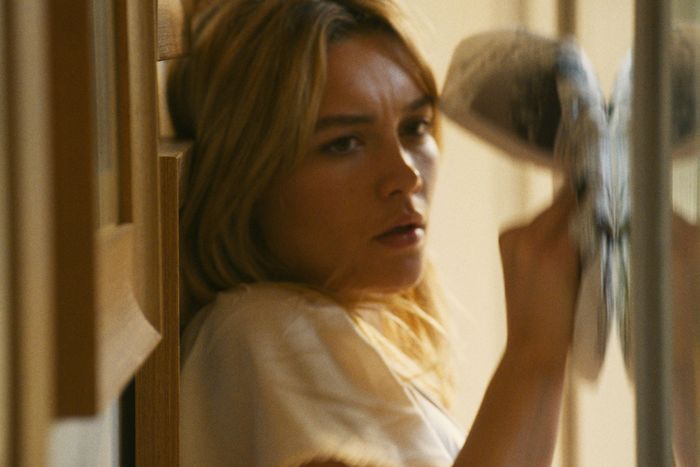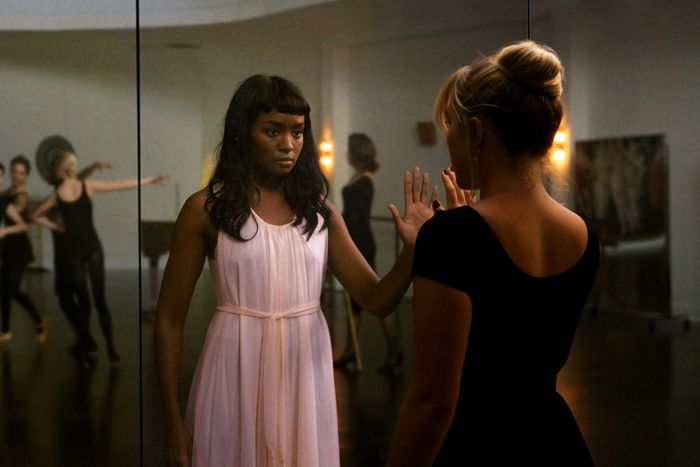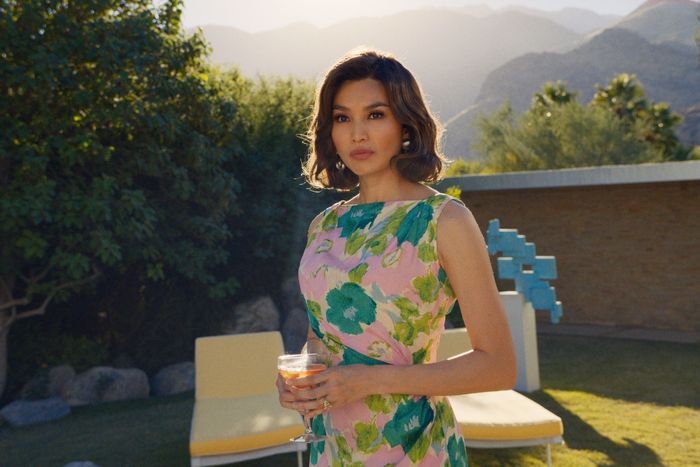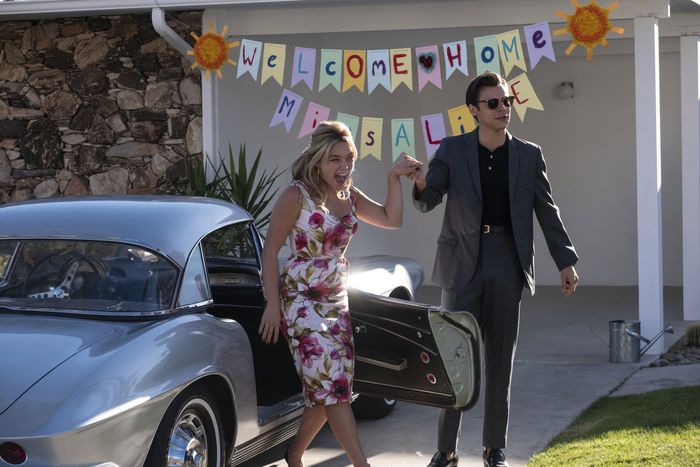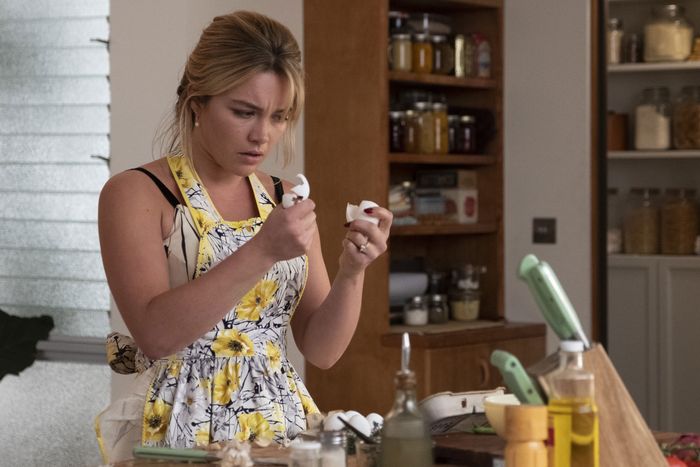
Spoilers follow for the film Don’t Worry Darling.
At a certain point, one must put gossip aside and dig into a piece of work on its own merits. Olivia Wilde’s sophomore feature, the drama-plagued Don’t Worry Darling, opened to a $19 million box-office opening in September and is now streaming on HBO Max. The movie’s twist ending aims to deliver a head trip, to limited effect — the film is so obvious in its attempt to evoke one that its self-consciousness ends up being self-defeating.
The film stars Florence Pugh and Harry Styles as married couple Alice and Jack, who seemingly live in the 1950s in a planned community plopped in the middle of the desert. While Jack works on “progressive materials” for the secretive Victory Project, Alice cooks, cleans, shops, socializes, and drinks with the other Victory Project wives who live in her cul-de-sac. But when Alice realizes something is deeply wrong with this place and with its leader, Frank (Chris Pine), Jack is unsympathetic. Their difference in opinion leads to a mid-film twist that attempts to mash together The Stepford Wives with movies like Strange Days, Get Out, and Serenity, plus some commentary on toxic masculinity.
The reveal is this: Everyone in Victory is living in a simulation designed by Frank, who in our real (present-day) world is an incel-like cult leader who has brainwashed men to pay him to live in a virtual-reality simulation of the 1950s. (Wilde has compared Frank to Jordan Peterson.) On the outside, those men have all abducted and restrained the women who appear in the Victory simulation. While the “husbands” are allowed to move in and out of virtual space so they can work and pay Frank, their “wives” are trapped — until the hair-bow-wearing Alice, like the one in Lewis Carroll’s Adventures in Wonderland, wakes up.
The twist doesn’t deliver much impact. Wilde and screenwriter Katie Silberman’s intentions — “It’s gaslighting, get it?” — are so clear from the beginning that the film never quite escapes the shadow of all that expectation. (At least the missing comma from the film’s title is innocent.) Along the way, Don’t Worry Darling unfurls a series of moments that make you go, “Wait, what?” In an attempt to parse the film’s half-baked interior logic and sparse character motivations, we’ve compiled a list of lingering questions. Like Alice running up that desert hill toward freedom or Spitgate conspiracy theorists, we are, in fact, still worrying.
1.
What’s up with the blood spot–single eye–dancing ladies montage?
In her promotion for Don’t Worry Darling, Wilde talked up the music cue that Styles, her current boyfriend, wrote in five minutes for a snippet of music that haunts Alice in the film. Alice can’t remember where she heard it, just as she can’t remember her life before coming to Victory, and in the film’s final minutes, it’s revealed that in the outside world, Jack used to sing it to his girlfriend, hardworking surgeon Alice, before he went all unshowered, unemployed, long-haired incel. He used the song to woo her and then to placate her, and it acts as a kind of hypnotic trigger to keep her in the simulation. Fine! But what never quite checks out is the montage of images that drives home how Alice is stuck in this virtual-reality world: a blood spot that looks like a Rorschach test, a single eye, and a group of dancing women in black and white whose legs moving in unison create a circular shape that evokes the aforementioned eye.
Don’t Worry Darling doesn’t have to lay everything out for us, but none of these images and ideas feels interconnected or revelatory. What is the purpose of the wives’ dance class? Why choose these three images as part of Alice’s brainwashing? Are the words intoned by Frank’s wife, Shelley (Gemma Chan) — “There is beauty in control. We move as one” — meant to evoke the Camazotz planet in A Wrinkle in Time, another Chris Pine movie, or am I reading too much into this? Put plainly: How does this film’s visual language complement its narrative? And that leads us to …
2.
What causes the glitches in the simulation?
Don’t Worry Darling flirts with horror in making Alice a witness, and occasionally a victim, of the aberrations in her home (walls that move and nearly crush her, empty eggshells, lost time, a mirror reflection that moves independently, à la Black Swan), and at one point she tests her reality by wrapping plastic wrap around her head. I suppose we’re meant to perceive these moments as glitches in the simulation? In other media about virtual realities (like The Matrix), glitches are explained as leftover bits of code or intrusions of self-awareness (as in Serenity). The latter may be what Don’t Worry Darling is going for, but if so, what’s causing the danger to Alice in the simulation? What triggers the house’s trying to harm her? Victory seems to be punishing Alice for asking questions, but how does the simulation’s coding understand what Alice is feeling when no one else, including her husband, does?
3.
Did the production get a good deal on carrots and lemons?
Don’t Worry Darling is so ominous from the beginning that the film seems to encourage us to look for clues about what it all means. Under that framework, produce is fair game! In two scenes, characters chow down on carrots when plenty of other vegetables are available, and in two other scenes, women randomly slice lemons for seemingly no purpose. Now, I cannot deny the crisp-sweet appeal of a carrot — but in two out of two veggie-preparation scenes? What does it mean? Were celery and zucchini not available? And those lemon slices: Alice and Shelley aren’t garnishing drinks with them, candying them for a cake, or baking them with a salmon. The lemon slices just sit on their cutting boards! Why make Florence Pugh and Gemma Chan practice their knife skills? This isn’t The Bear!
4.
What else do Margaret and Ted do that we don’t see?
One of Don’t Worry Darling’s messiest elements is its Get Out–like use of Kiki Layne’s Margaret (the only Black woman with a speaking role in this film) to point out to Alice that something is wrong with Victory. Margaret is ostracized and mocked by the other wives after she says she saw something in the desert, wanders out to find it, and then starts talking about her nightmares. Alice rejects Margaret when she asks for help, and eventually Margaret slits her own throat in front of her, which galvanizes Alice to realize that something truly is amiss here in their idyllic little company town. It’s a thankless role for Layne, whose character is purely figurative and never really internal. And despite repeated allusions to how close Alice and Margaret used to be, we never see any of that. Lo and behold, over the weekend, Layne posted on Instagram that most of her scenes, along with Ari’el Stachel’s Ted, were cut from the film, adding another layer to this production’s seemingly endless behind-the-scenes intrigue. Layne and Stachel are now dating, which is nice. But in Don’t Worry Darling, it’s a little too unintentionally reminiscent of the 1950s to have the pain of a Black woman launch a white woman’s feminism, no?
5.
What’s Shelley’s deal?
For a movie that presents itself like that GIF of Saoirse Ronan in Little Women passionately saying “Women have minds!” for two hours, Don’t Worry Darling is strangely slight on the lives of said women — except for Bunny, the character Wilde herself plays, who gets a backstory about missing children (maybe dead, maybe lost in a custody battle; the film is unclear about this) and is complicit with the simulation because she actually chose to live in it. We’ve already pondered the thinness of Layne’s Margaret, so let’s turn our attention to Gemma Chan’s Shelley, who at first is presented as a loyal wife to Pine’s Frank — the gorgeous, graceful head of the wives. She teaches the women ballet, implores them all to know their place, procures Dita Von Teese as a surprise for Frank (does that mean Shelley, in the real world, abducts the famous burlesque star?!), and shuts down Alice when she starts talking about Frank’s brainwashing and controlling them all. But in the finale, when Alice has made her way to the portal to the outside world, Shelley turns on Frank and stabs him with a butcher knife, telling him, “You stupid, stupid man. It’s my turn now.”
Given what else Shelley does in the film, this moment feels almost like a villain reveal: as if Shelley, like Bunny, were actively involved in maintaining the simulation the whole time and intends to step into Frank’s power role now that it’s clear he can’t keep the compound safe. Nothing else happens with Shelley, though, so that line of dialogue and what “my turn” means for her remain infuriatingly vague. The simplest reading here is that Shelley’s revolt suggests the other wives are rebelling against their husbands too. But her about-face is so abrupt it invites more confusion than solidarity.
6.
What’s the point of that crashing plane?
First Margaret sees something in the desert and then Alice experiences something similar: While traveling on the town’s trolley service, she sees a red biplane smoking across the city. Her curiosity sends her, like Margaret, into the desert, where she comes upon Victory’s mysterious headquarters and begins to experience jarring memory intrusions from the past. But how does this happen? Is the plane a kind of built-in fidelity test for the simulation to figure out who’s already wavering? Or is it, like the house attacking Alice, some kind of coding glitch? Why would Frank code something that could endanger his whole project? That’s all a bit nonsensical. And what’s with the red-jumpsuit-wearing guys, who chase Alice once she has killed Jack and returned to the desert to try to break into the real world? Why didn’t they go after her the first time she ventured out there, to avoid her finding the portal in the first place? Are they this film’s version of the virus-replicating Mr. Smiths who chase after Neo and Trinity, or are they just other incels who signed up to, I don’t know, abuse women without the burden of marriage in virtual reality? These are absolutely nitpicky questions about the inner workings of Frank’s code, but Don’t Worry Darling invites such pondering and then doesn’t explain it.
7.
What percentage of items in the husbands’ mid-century “catalogue” are mirrors?
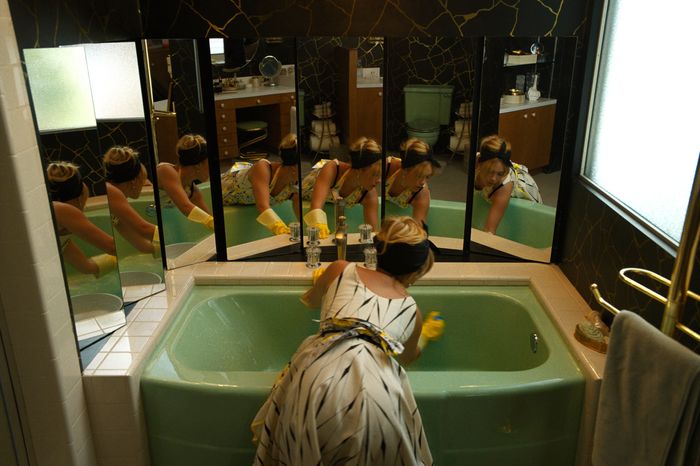
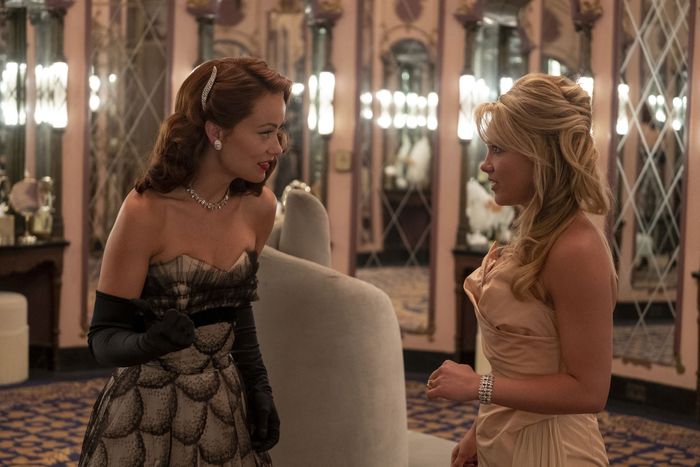
There’s a scene toward the end of the film when Jack and Alice throw a dinner party and invite their friends and Frank and Shelley over and the husbands are amazed at the perfection of the couple’s mid-century home. The sunken living room! All the beautiful glassware! The record player! One of the husbands asks Jack if he ordered everything in the house from the “catalogue,” and as someone who grew up with the visceral thrill of having the Delia’s and Sharper Image catalogues arrive in my family’s mailbox, I have questions. Within the simulation itself, I’m assuming that ordering from the catalogue is like re-upping your supplies, but why is everyone so surprised by the niceness of Jack’s house? Is he paying Frank more to get better material goods — is that why he gets promoted to Frank’s inner circle? Do items just magically appear once you order them, or how do the physics of the simulation work? Is this catalogue really pushing mirrors for some reason? Look at all the reflections in Jack and Alice’s bathroom and all the reflections in the club where Frank forces Jack to dance for the cheering crowd. What else does this catalogue offer in terms of homeware accessories? Could I order Alice’s beautiful bordeaux nail polish from there? What scrap of capitalist product can I purchase to pretend that I too am living in the Volcano House, just without all the mind-control stuff? I need to know!
8.
Oh, and about that scene of Jack dancing … why?
That’s the entirety of my question. Would incels really be into Styles’s Jack flipping, twirling, and tap-dancing all across that stage? That seems incongruous.
9.
So the “female pleasure” Wilde kept hyping is rape, right?
Let’s turn to the Variety profile in which Wilde says of Don’t Worry Darling’s sex scenes: “Men don’t come in this film. Only women here!” and “In hetero sex scenes in film, the focus on men as the recipients of pleasure is almost ubiquitous.” Sure, if you watch Don’t Worry Darling and stop the film before the final twist, the fact that Jack seemingly prefers catering to Alice is nice — he performs oral sex on her a couple of times, he fingers her, he brings her to orgasm. Meanwhile, we don’t see Alice do the same to him, and I guess in that reading, Wilde is correct: “Men don’t come in this film.” But once the simulation is revealed, those sex scenes are absolutely recontextualized as Jack doing things to Alice’s body to which she cannot consent. “The impractical nature of their sex speaks to their ferocious desire for one another,” Wilde also said to Variety, but doesn’t it actually speak to the fact that one of them is assaulting the other? It’s odd to hype your film as a feminist triumph given this framing! (Pugh didn’t seem to like how those scenes were presented in the marketing, either, given that she told Harper’s Bazaar, “When it’s reduced to your sex scenes, or to watch the most famous man in the world go down on someone, it’s not why we do it. It’s not why I’m in this industry.”)
10.
Is “Miss Alice” a nod to “Miss Flo”?
See the banner behind Alice’s and Jack’s heads? Olivia, you’re wild for this one.
More on Don't Worry Darling
- The Cheap Tricks of Me Too Thrillers
- How Did Don’t Worry Darling Become So Worrying?
- The Best Fake Podcasts of the Year



